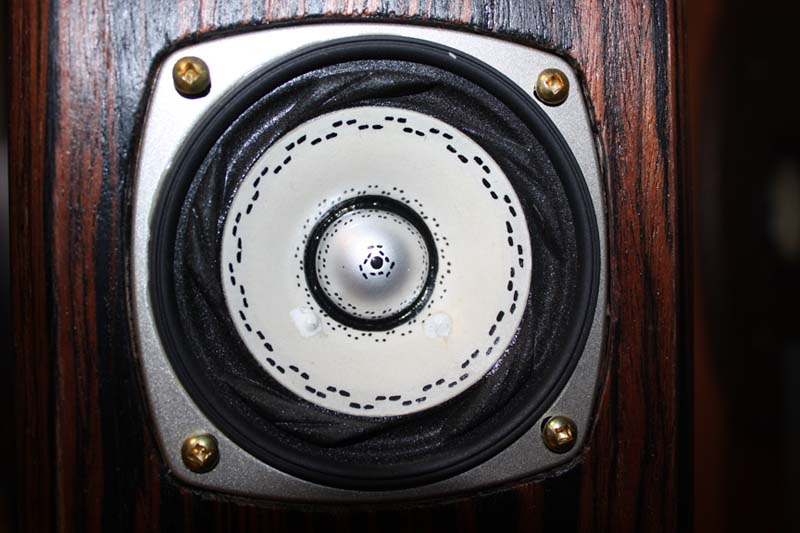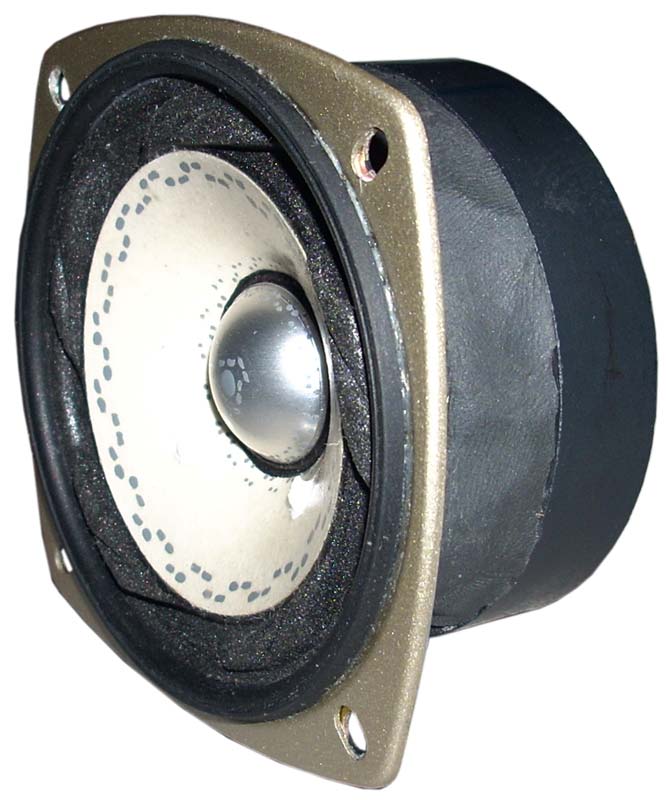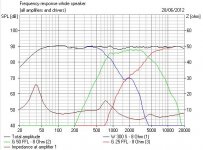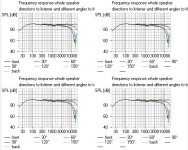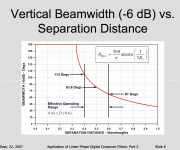Member
Joined 2009
So somehow I became interested in eliminating driver lobing at the crossover. It looks ugly in polar graphs I suppose..
I tend to be biased against the obvious solutions of using a fullrange or coaxial speaker so the most sensible approach is to use a very low crossover point and put the drivers as close together as physically possible. Basically what happens is as drivers are spaced further apart and the crossover rises in frequency cancellations begin to form on the vertical axis. With many popular designs the listening window can be as small as 20 degrees vertically. Xdir is a great FREE program that can simulate the directivity pattern of a given crossover scenario.
Below is a crude simulation of what this phenomena would look like if say you built a speaker that can color the air in neon green and blue. On the left, 2 point source drivers interact destructively at high frequencies to paint a nice psychedelic blooming neon.. semi-flower? On the right, the same 2 drivers interact well together at low frequencies.
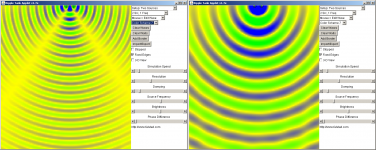
I built a quick prototype to test this idea. I decided to use the Vifa NE19VTA and the HIVI B3S because of their small sizes, low price and excellent reviews on Zaph Audio.
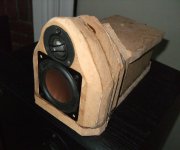
When it comes down to cramming 2 drivers close together how close is close enough? I'm going with the assumption that the lobing effects are negligible when the centers of the drivers are spaced less than a 1/4 of the crossover frequency wavelength. Following that rule Xdir informs us that cancellations will tame the response at 90 degrees off-axis by -3dB. I think that is acceptable even by hardcore audiophiles and as I will show later, real life results are often much better than expected.
The distance between the 2 drivers in my setup is 60mm requiring a crossover point of 1400Hz. I cut a piece of the tweeter flange but the measurements look so promising I think I could've kept it in it's entire glory. The measurements show 30, 60 and 90 degrees off center, 1m away on the tweeter. The on axis frequency response is missing because it looks almost identical to the 30 degrees curve and HOLMimpulse lets me have only up to 3 curves.
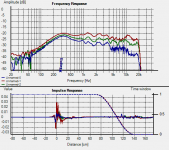
I like what I'm seeing (and hearing) a lot and I am going ahead with a 3-way implementation. I'd like to hear some comments from you guys!
I tend to be biased against the obvious solutions of using a fullrange or coaxial speaker so the most sensible approach is to use a very low crossover point and put the drivers as close together as physically possible. Basically what happens is as drivers are spaced further apart and the crossover rises in frequency cancellations begin to form on the vertical axis. With many popular designs the listening window can be as small as 20 degrees vertically. Xdir is a great FREE program that can simulate the directivity pattern of a given crossover scenario.
Below is a crude simulation of what this phenomena would look like if say you built a speaker that can color the air in neon green and blue. On the left, 2 point source drivers interact destructively at high frequencies to paint a nice psychedelic blooming neon.. semi-flower? On the right, the same 2 drivers interact well together at low frequencies.

I built a quick prototype to test this idea. I decided to use the Vifa NE19VTA and the HIVI B3S because of their small sizes, low price and excellent reviews on Zaph Audio.

When it comes down to cramming 2 drivers close together how close is close enough? I'm going with the assumption that the lobing effects are negligible when the centers of the drivers are spaced less than a 1/4 of the crossover frequency wavelength. Following that rule Xdir informs us that cancellations will tame the response at 90 degrees off-axis by -3dB. I think that is acceptable even by hardcore audiophiles and as I will show later, real life results are often much better than expected.
The distance between the 2 drivers in my setup is 60mm requiring a crossover point of 1400Hz. I cut a piece of the tweeter flange but the measurements look so promising I think I could've kept it in it's entire glory. The measurements show 30, 60 and 90 degrees off center, 1m away on the tweeter. The on axis frequency response is missing because it looks almost identical to the 30 degrees curve and HOLMimpulse lets me have only up to 3 curves.

I like what I'm seeing (and hearing) a lot and I am going ahead with a 3-way implementation. I'd like to hear some comments from you guys!
When it comes down to cramming 2 drivers close together how close is close enough? I'm going with the assumption that the lobing effects are negligible when the centers of the drivers are spaced less than a 1/4 of the crossover frequency wavelength. ...
The distance between the 2 drivers in my setup is 60mm requiring a crossover point of 1400Hz.
In my MTM i achieved <1/4 wl by moving the XO down to <400 Hz. (6.5" modwoofers/3" mid-tweeter)
dave
Member
Joined 2009
In my MTM i achieved <1/4 wl by moving the XO down to <400 Hz. (6.5" modwoofers/3" mid-tweeter)
dave
MTM designs have the worst vertical directivity because the 2 woofers are spaced too far apart to work constructively into high frequencies. At 400Hz you can have the same vertical directivity with a single 10" to that 3". What was your idea about using 2 drivers instead of 1? Can two 6.5" woofer combine to have a lower distortion in the bass region than a single 10" at comparable cost?
How does the tweeter not fall off the chart above 10khz and 90 degrees off axis?
And what kind of XO did you use? I would assume that a shallow XO would extend the useable portion woofer higher into the frequency range causing lobing to occure, but if the XO is steep, then it'll be less noticeable. This this has to be a part of your experiment I think.
And what kind of XO did you use? I would assume that a shallow XO would extend the useable portion woofer higher into the frequency range causing lobing to occure, but if the XO is steep, then it'll be less noticeable. This this has to be a part of your experiment I think.

Woofers are less than 1/4 w/l apart at the XO (which calcs closer to 300 than 400 -- with 1st series XO i don't know exactly -- it would be considered a FAST). Midtweeters are closer than 1/8 w/l from each midwoofer. I've always wanted to do an MTM "right". Woofers were a nice price ($60/pr), i liked the way they looked. They give lots of nice finessed bass. Midtweeter has what is essentially a 3/4" tweeter in the middle, it has claimed extension to 32kHz, and has few issues with directivity. If they are here when you next visit (Chris is thinking of borrowing them to play with bi-amping using a no feedback SEP on the top, and then finish them)
Geddes work shows that concern over distortion is overrated.
dave
Member
Joined 2009
How does the tweeter not fall off the chart above 10khz and 90 degrees off axis?
I specifically picked the Vifa-NE19VTA tweeter because of it's excellent dispersion at high frequencies. Below is the HORIZONTAL 0-60 graph from Zaph Audio.
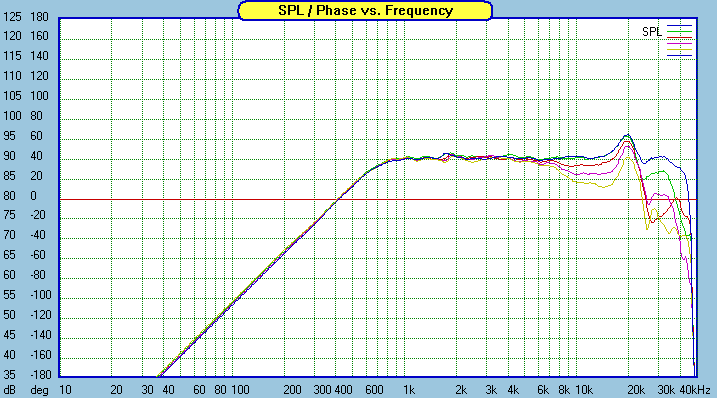
My own measurements are very similar to his. Just for reference this what I get for HORIZONTAL at 30-60-90 degrees(the on-axis is not shown but is almost identical to 30deg). I have a shelving filter for baffle step compensation and a lowpass at around 15KHz to tame the rising high end.
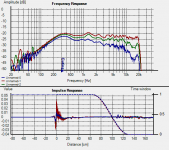
The crossover is a 4th order Linkwitz-Riley at 1400Hz, all active in DSP. I definitely want to experiment with 2nd order and higher frequencies and will post my findings here.
Member
Joined 2009
Dave,
Very interesting subject. You have managed a 1/4 wavelength at the crossover frequency. Is it still 1400 Hz, or did you lower it 400 Hz?
Do you consider lobing to be a more detrimental effect than crossing over in the so called "the ears most sensitive region"? Most people seem to cross in this region anyway, so is there a problem, and how do you in that case solve it? I have tried to get a grip on this subject, but I've failed so far.
I'am planning a MTM but have choosen to go above "the region" so I have only approx. 1 wavelenth at my crossing over frequency. C-C is 90mm.
Very interesting subject. You have managed a 1/4 wavelength at the crossover frequency. Is it still 1400 Hz, or did you lower it 400 Hz?
Do you consider lobing to be a more detrimental effect than crossing over in the so called "the ears most sensitive region"? Most people seem to cross in this region anyway, so is there a problem, and how do you in that case solve it? I have tried to get a grip on this subject, but I've failed so far.
I'am planning a MTM but have choosen to go above "the region" so I have only approx. 1 wavelenth at my crossing over frequency. C-C is 90mm.
LOBING ?
OK you have read this far, and you are as confused as I am ?
Lets begin with that 1/4 wavelength rule; where did you get that?
Lobing "is the cancellation that occurs because of distance differential between two drivers."(to the listener)
The frequency of cancellation is one half the distance differential.
Therefore, 1/2 of 60mm equals approx. 11,500 hz or four octaves above the proposed 1400 hz crossover.
While I concede the differential gets large in the vertical off axis beyond +/- 10 degrees (20 degrees), this angle petty much covers the first arrival in most rooms. Unless you are concerned with ceiling and floor reflections.
Can anyone shed some light on this? I guess I am suggesting a 2 wavelength rule as apposed to this post's 1/4 wavelength rule?
OK you have read this far, and you are as confused as I am ?
Lets begin with that 1/4 wavelength rule; where did you get that?
Lobing "is the cancellation that occurs because of distance differential between two drivers."(to the listener)
The frequency of cancellation is one half the distance differential.
Therefore, 1/2 of 60mm equals approx. 11,500 hz or four octaves above the proposed 1400 hz crossover.
While I concede the differential gets large in the vertical off axis beyond +/- 10 degrees (20 degrees), this angle petty much covers the first arrival in most rooms. Unless you are concerned with ceiling and floor reflections.
Can anyone shed some light on this? I guess I am suggesting a 2 wavelength rule as apposed to this post's 1/4 wavelength rule?
Two things:
1) Dropping response starts where there is a phase-difference larger than 0 degrees. It would be impossible to maintain this for all frequencies and angles so one must take a practicable value to start with (and which can still be difficult to achieve in practice !).
2) You are off by a factor of four: you should not take half of the distance as wavelength of the frequency in question. You should take the frequency for which the 60 mm are 1/2 of the wavelength. I.e. a frequency with a wavelength of 120mm which is 2800 Hz.
This might be practicable in some situations but for the picky ones the 3db drop caused by the 90 degrees that would occur at 1400 Hz is already too much.
Regards
Charles
1) Dropping response starts where there is a phase-difference larger than 0 degrees. It would be impossible to maintain this for all frequencies and angles so one must take a practicable value to start with (and which can still be difficult to achieve in practice !).
2) You are off by a factor of four: you should not take half of the distance as wavelength of the frequency in question. You should take the frequency for which the 60 mm are 1/2 of the wavelength. I.e. a frequency with a wavelength of 120mm which is 2800 Hz.
This might be practicable in some situations but for the picky ones the 3db drop caused by the 90 degrees that would occur at 1400 Hz is already too much.
Regards
Charles
Carefully done, a 3 way with dome midrange eliminates lobing. Here 800Hz and 4kHz crossover. 
I wasn't believing what I was seeing when I first simmed the classic Acoustic Research AR-3A and Celestion Ditton 66 3 way loudspeakers. First or second order crossover both work beautifully. Spacing was 20 cm and 10 cm between driver acoustic centres but no baffle time alignment necessary for exemplary phase alignment.
The typical 0.16mH Visaton G50 FFL is a lovely driver:
Visaton - Lautsprecher und Zubehör, Loudspeakers and Accessories
The fact that I was crossing over with low inductance drivers below troublesome frequencies made the filters easy. At crossover the drivers both maintained good dispersion too. You can see a case for a supertweeter here. This simply doesn't work so well with a 5" cone midrange driver because its acoustic centre is further back than with a dome and its dispersion is poorer.
I wasn't believing what I was seeing when I first simmed the classic Acoustic Research AR-3A and Celestion Ditton 66 3 way loudspeakers. First or second order crossover both work beautifully. Spacing was 20 cm and 10 cm between driver acoustic centres but no baffle time alignment necessary for exemplary phase alignment.
The typical 0.16mH Visaton G50 FFL is a lovely driver:
Visaton - Lautsprecher und Zubehör, Loudspeakers and Accessories
The fact that I was crossing over with low inductance drivers below troublesome frequencies made the filters easy. At crossover the drivers both maintained good dispersion too. You can see a case for a supertweeter here. This simply doesn't work so well with a 5" cone midrange driver because its acoustic centre is further back than with a dome and its dispersion is poorer.
Attachments
Member
Joined 2009
OK you have read this far, and you are as confused as I am ?
Lets begin with that 1/4 wavelength rule; where did you get that?
Lobing "is the cancellation that occurs because of distance differential between two drivers."(to the listener)
The frequency of cancellation is one half the distance differential.
Therefore, 1/2 of 60mm equals approx. 11,500 hz or four octaves above the proposed 1400 hz crossover.
While I concede the differential gets large in the vertical off axis beyond +/- 10 degrees (20 degrees), this angle petty much covers the first arrival in most rooms. Unless you are concerned with ceiling and floor reflections.
Can anyone shed some light on this? I guess I am suggesting a 2 wavelength rule as apposed to this post's 1/4 wavelength rule?
This experiment was based on simulations with xDir.
Tolvan Data
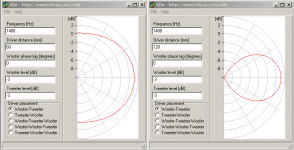
This simulation shows the vertical polar with driver spacing of 1/4 and 1/2 wavelength. 1/2 gives a coverage of about +-30degrees which as you said is sufficient in most cases.
1/4 distance would benefit more specialized cases - for example listening to music while laying on floor or building something unconventional like the Linkwitz Pluto.
So... Someone just out of the blue "declares" that lobing is a problem and all of a sudden, people pile on with "solutions" that only mirror that one dimensional "mistake".
Lobing is not necessarily a problem unless we can define a UseCase (like listening way off access) where it would cause an audible issue - greater than other problems in that same UseCase.
If we limit this discussion to home audio, the world looks much different. We have ceiling and floor reflections that can be very well managed with proper lobing. The phantom images in living spaces are no different than additional sources of sound. If we consider typical "serious listening" locations in relation to the speakers, we can even plot how much lobing is possible(beneficial) with no effect on the direct sound. I consider wide dispersion to be a real problem for systems used for "serious" listening. Room issues are multiplied and then require massive treatment that could have been avoided in the first place.
Lobing IS a huge issue in PA. We certainly do not want half of the audience to only get half of the music.
I am exploring lobing and proximity issues at LF (<100Hz) in typical home listening environments.
Lobing is not necessarily a problem unless we can define a UseCase (like listening way off access) where it would cause an audible issue - greater than other problems in that same UseCase.
If we limit this discussion to home audio, the world looks much different. We have ceiling and floor reflections that can be very well managed with proper lobing. The phantom images in living spaces are no different than additional sources of sound. If we consider typical "serious listening" locations in relation to the speakers, we can even plot how much lobing is possible(beneficial) with no effect on the direct sound. I consider wide dispersion to be a real problem for systems used for "serious" listening. Room issues are multiplied and then require massive treatment that could have been avoided in the first place.
Lobing IS a huge issue in PA. We certainly do not want half of the audience to only get half of the music.
I am exploring lobing and proximity issues at LF (<100Hz) in typical home listening environments.
- Home
- Loudspeakers
- Multi-Way
- An exploration in eliminating driver lobing
